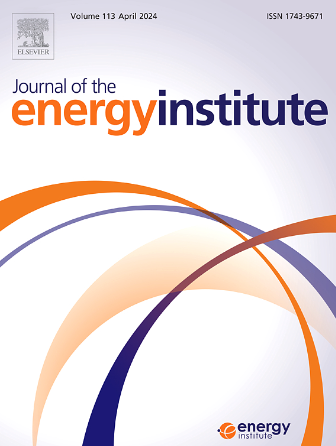Catalytic hydrothermal liquefaction of algae biomass for the production of high quality bio-oil: Effects of active metals and reaction process parameters
IF 5.6
2区 工程技术
Q2 ENERGY & FUELS
引用次数: 0
Abstract
Catalytic hydrothermal liquefaction (HTL) has the potential to convert wet Nannochloropsis algae (NA) biomass waste into high-quality bio-oil. This study systematically investigates the effects of Ni, Ce, and Ce-Ni bimetals supported on ZnAl₂O₄ in enhancing bio-oil yield and quality. The bimetallic Ni-Ce/ZnAl₂O₄ catalyst in HTL of NA, using ethanol as a solvent, produced the highest bio-oil yield (56.8 wt%) compared to methanol (54.0 wt%) and water (43.8 wt%) at 280 °C for a reaction time of 45 min. The obtained bio-oils were characterized using various analytical methods. Compared to non-catalytic liquefaction, the Ni-Ce bimetallic catalysts significantly promoted hydrodeoxygenation and esterification, enhancing bio-oil quality. The highest yields of hydrocarbons (13.52 %) and esters (69.86 %) in the bio-oil were achieved using the Ni-Ce catalyst supported on ZnAl₂O₄. Furthermore, during catalytic liquefaction, the bio-oil exhibited a carbon content of 78.9 wt% and an oxygen content reduced to 13.3 wt%, resulting in a higher HHV of 35.6 MJ/kg bio-oil obtained. The introduction of Ni-Ce bimetallic catalysts also increased the low boiling point to 44.5 % containing function compounds in the bio-oil. The Ni-Ce/ZnAl₂O₄ catalyst demonstrated excellent stability and reusability, maintaining its performance after five cycles. These experimental findings provide valuable insights for future research on the aquatic algae biomass into quality bio-oil production.
催化水热液化(HTL)具有将湿的南极海藻(NA)生物质废物转化为高质量生物油的潜力。本研究系统研究了 ZnAl₂O₄上支撑的镍、铈和铈镍双金属对提高生物油产量和质量的影响。双金属 Ni-Ce/ZnAl₂O₄ 催化剂在以乙醇为溶剂的 NA HTL 中,与甲醇(54.0 wt%)和水(43.8 wt%)相比,在 280 °C、45 分钟的反应时间内产生的生物油产量(56.8 wt%)最高。使用各种分析方法对所获得的生物油进行了表征。与非催化液化相比,Ni-Ce 双金属催化剂显著促进了加氢脱氧和酯化反应,提高了生物油的质量。使用 ZnAl₂O₄支撑的 Ni-Ce 催化剂,生物油中碳氢化合物(13.52%)和酯类(69.86%)的产率最高。此外,在催化液化过程中,生物油的碳含量为 78.9 wt%,氧含量降至 13.3 wt%,从而获得了 35.6 MJ/kg 生物油的较高 HHV。Ni-Ce 双金属催化剂的引入还将生物油中含功能化合物的低沸点提高到 44.5%。Ni-Ce/ZnAl₂O₄ 催化剂表现出卓越的稳定性和可重复使用性,在五个循环后仍能保持其性能。这些实验结果为今后研究水生藻类生物质生产优质生物油提供了宝贵的启示。
本文章由计算机程序翻译,如有差异,请以英文原文为准。
求助全文
约1分钟内获得全文
求助全文
来源期刊

Journal of The Energy Institute
工程技术-能源与燃料
CiteScore
10.60
自引率
5.30%
发文量
166
审稿时长
16 days
期刊介绍:
The Journal of the Energy Institute provides peer reviewed coverage of original high quality research on energy, engineering and technology.The coverage is broad and the main areas of interest include:
Combustion engineering and associated technologies; process heating; power generation; engines and propulsion; emissions and environmental pollution control; clean coal technologies; carbon abatement technologies
Emissions and environmental pollution control; safety and hazards;
Clean coal technologies; carbon abatement technologies, including carbon capture and storage, CCS;
Petroleum engineering and fuel quality, including storage and transport
Alternative energy sources; biomass utilisation and biomass conversion technologies; energy from waste, incineration and recycling
Energy conversion, energy recovery and energy efficiency; space heating, fuel cells, heat pumps and cooling systems
Energy storage
The journal''s coverage reflects changes in energy technology that result from the transition to more efficient energy production and end use together with reduced carbon emission.
 求助内容:
求助内容: 应助结果提醒方式:
应助结果提醒方式:


